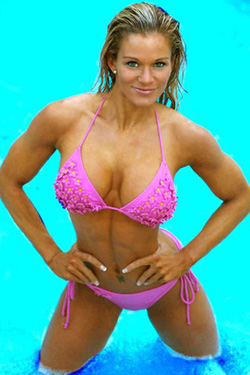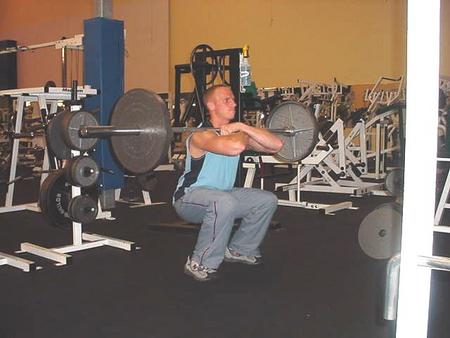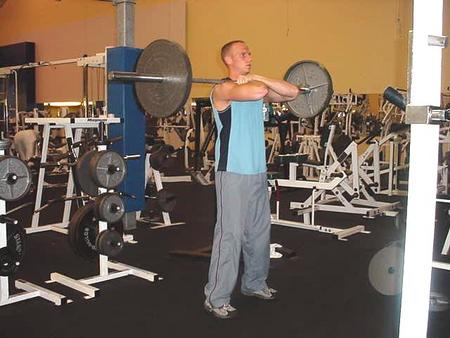Front Squats - The Ultimate Hard-Body Exercise
by Mike Geary
As you may have already discovered, the squat is at the top of the heap (along with deadlifts) as one of the most effective overall exercises for stimulating body composition changes (muscle gain and fat loss). This is because exercises like squats and deadlifts use more muscle groups under a heavy load than almost any other weight bearing exercises known to man. Hence, these exercises stimulate the greatest hormonal responses (growth hormone, testosterone, etc.) of all exercises.
 In fact, university research studies have even proven that inclusion of squats into a training program increases upper body development, in addition to lower body development, even though upper body specific joint movements are not performed during the squat. Whether your goal is gaining muscle mass, losing body fat, building a strong and functional body, or improving athletic performance, the basic squat and deadlift (and their variations) are the ultimate solution.
In fact, university research studies have even proven that inclusion of squats into a training program increases upper body development, in addition to lower body development, even though upper body specific joint movements are not performed during the squat. Whether your goal is gaining muscle mass, losing body fat, building a strong and functional body, or improving athletic performance, the basic squat and deadlift (and their variations) are the ultimate solution.
If you don’t believe me that squats and deadlifts are THE basis for a lean and powerful body, then go ahead and join all of the other overweight people pumping away mindlessly for hours on boring cardio equipment. You won’t find long boring cardio in any of my programs in The Truth About Six Pack Abs.
Squats can be done with barbells, dumbbells, kettlebells, or even just body weight. Squats should only be done with free weights – NEVER with a Smith machine! My book, The Truth About Six Pack Abs contains the full story on why machines are so inferior and even potentially DANGEROUS compared to free weights.
The type of squat that people are most familiar with is the barbell back squat where the bar is resting on the trapezius muscles of the upper back. Many professional strength coaches believe that front squats (where the bar rests on the shoulders in front of the head) and overhead squats (where the bar is locked out in a snatch grip overhead throughout the squat) are more functional to athletic performance than back squats with less risk of lower back injury.
I feel that a combination of all three (not necessarily during the same phase of your workouts) will yield the best results for overall muscular development, body fat loss, and athletic performance. Front squats are moderately more difficult than back squats, while overhead squats are considerably more difficult than either back squats or front squats. I’ll cover overhead squats in a future newsletter issue.
If you are only accustomed to performing back squats, it will take you a few sessions to become comfortable with front squats, so start out light. After a couple sessions of practice, you will start to feel the groove and be able to increase the poundage.
To perform front squats:
The front squat recruits the abdominals to a much higher degree for stability due to the more upright position compared with back squats. It is mostly a lower body exercise, but is great for functionally incorporating core strength and stability into the squatting movement. It can also be slightly difficult to learn how to properly rest the bar on your shoulders. There are two ways to rest the bar on the front of the shoulders.
In the first method, you step under the bar and cross your forearms into an “X” position while resting the bar on the dimple that is created by the shoulder muscle near the bone, keeping your elbows up high so that your arms are parallel to the ground. You then hold the bar in place by pressing the thumb side of your fists against the bar for support.
Alternatively, you can hold the bar by placing your palms face up and the bar resting on your fingers against your shoulders. For both methods, your elbows must stay up high to prevent the weight from falling. Your upper arms should stay parallel to the ground throughout the squat. Find out which bar support method is more comfortable for you.
Then, initiate the squat from your hips by sitting back and down keeping the weight on your heels as opposed to the balls of your feet. Squat down to a position where your thighs are approximately parallel to the ground, then press back up to the starting position. Keeping your weight more towards your heels is the key factor in squatting to protect your knees from injury and develop strong injury resistant knee joints.
Keep in mind – squats done correctly actually strengthen the knees; squats done incorrectly can damage the knees. Practice first with an un-weighted bar or a relatively light weight to learn the movement. Most people are surprised how hard this exercise works your abs once you learn the correct form.
START/FINISH

MIDPOINT

For complete descriptions of over 50 of the most effective exercises for stripping away body fat while developing a rock-hard body, download my e-book The Truth About Six Pack Abs
Return to the Workout Articles Archive
|